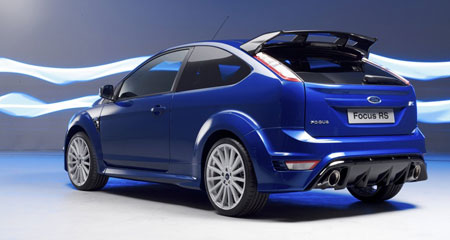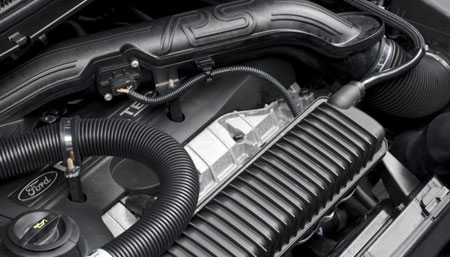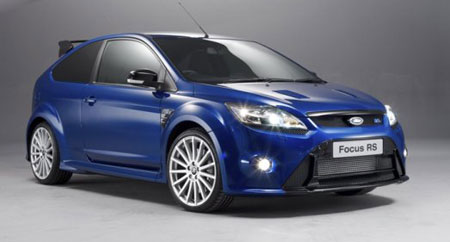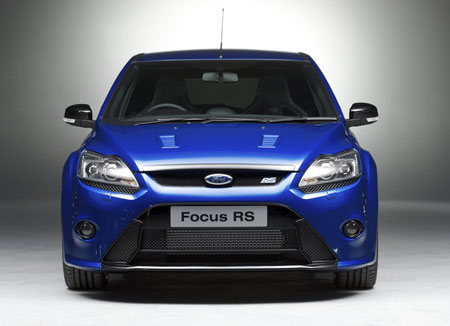
Ford has revealed more information on the powerplant in the Ford Focus RS engine bay. The inline-5 “Duratec RS” engine puts out 305 PS between 6,500rpm to 7,050rpm (redline) and a massive 440Nm of torque between 2,300 and 4,500rpm, a good 40Nm more at the peak than the BMW M3. I believe one of the intentions of the press release are to dispel any talk that Ford simply took the easy way out and “rechipped” the Duratec ST engine to produce more power, as many had expected something more exciting such as maybe a twin turbo version with all-wheel drive.
“There was never an intention to try to ‘chip’ the ST engine. We evaluated several approaches using the ST engine and none gave us the combination of power delivery, character and durability that we wanted, so we opted to create an RS Duratec, using the ST unit as our base,” said Ford Team RS powertrain manager Len Urwin.

The engine gets a revised cylinder head gasket, metal-sprayed cylinder bores that are more durable, new pistons and a bespoke camshaft profile and conrods which allows bigger small-end bearings. The turbo has been uprated to a Borg Warner K16 that peaks out at 1.4 bar, double that of the Focus ST’s 0.7 bar boost. Ford says the turbo size was carefully picked to match the “bottom end responsiveness” of the Focus ST. The integration of the turbo to the exhaust manifold had to be strategically configured to optimise crash performance and minimize revisions to other components such as exhaust system, and oil and water pipes. It also has to take into account the car’s 20mm lower subframe.The engine’s larger intercooler can reduce air temperatures from 160 degrees Celsius at the compressor, to a maximum of 60 degrees Celsius at the intercooler outlet, in ambient temperatures of up to 38 degrees Celsius.
Urwin adds that Ford wanted to prevent the engine from feeling like it runs out of steam at the top end, something that turbo-ed engines with very flat torque curves sometimes exhibit. There is just so much of rush right from the start that you don’t feel the momentum of things picking up all the way until the end. Ford wanted to “reward” drivers who took the Duratec RS to the redline. In addition, the car’s rev needles can bounce up to 7,050rpm for about 3 seconds before it is rev-limited to 6,500rpm.

The 6-speed manual shares the same ratios as the Focus ST but has modifications to the bearing and clutch housing as well as had its differential strengthened to take the extra power and torque. The overall gearing is 1% longer than the ST thanks to the car’s larger tyres (larger rolling circumference), and this results in the RS being able to touch 100km/h in 2nd gear. To help manage 440Nm to the front wheels which also have to steer the car, Ford has employed the use of a Quaife helical LSD. This LSD is based on the one in the original 5-speed Focus RS from the year 2002, but revised for the new 6-speed 2009 Ford Focus RS. It now has a sixth planet gear and is stronger, with a more subtle intervention and torque transfer.

I’m sure when you look at the RS, you’ll notice the large gaping front bumper intake. This is actually part of the cooling requirement, in fact 80% of the engine’s external cooling is thanks to this front grille aperture, even down to the mesh density. The car also gets a 25% larger radiator, anda lso has a larger 14 plate engine-mounted water-cooled oil cooler. The bonnet louvres are also there for a reason, to help idle cooling especially after a high-speed run.
At the front, Ford uses a RevoKnuckle suspension. While regular suspension knuckles are a one-piece design; RevoKnuckle has instead two separate pieces. In place of the regular, inverted ‘L’-shaped lower suspension mount, RevoKnuckle features a ‘C’-shaped mount, connected to both the wheel hub, via two arms and to the strut, which is attached at its top. Apparently this allows greater flexibility in tuning suspension geometry to avoid torque steer. This is sort of a hybrid between a MacPherson strut and double wishbone design, which is good as it is cheaper than a double wishbone design.
Of course, you have to pay for performance not only in the price tag of a car, but naturally more power will burn more fuel so the Focus RS also has a larger fuel tank at 62 liters up from 55 liters in the Focus ST.


 07.03
07.03
 OS_C@R
OS_C@R








0 komentar:
Posting Komentar